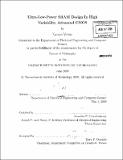| dc.contributor.advisor | Anantha P. Chandrakasan. | en_US |
| dc.contributor.author | Verma, Naveen | en_US |
| dc.contributor.other | Massachusetts Institute of Technology. Dept. of Electrical Engineering and Computer Science. | en_US |
| dc.date.accessioned | 2010-03-25T15:28:55Z | |
| dc.date.available | 2010-03-25T15:28:55Z | |
| dc.date.copyright | 2009 | en_US |
| dc.date.issued | 2009 | en_US |
| dc.identifier.uri | http://hdl.handle.net/1721.1/53305 | |
| dc.description | Thesis (Ph. D.)--Massachusetts Institute of Technology, Dept. of Electrical Engineering and Computer Science, 2009. | en_US |
| dc.description | Cataloged from PDF version of thesis. | en_US |
| dc.description | Includes bibliographical references (p. 163-181). | en_US |
| dc.description.abstract | Embedded SRAMs are a critical component in modern digital systems, and their role is preferentially increasing. As a result, SRAMs strongly impact the overall power, performance, and area, and, in order to manage these severely constrained trade-offs, they must be specially designed for target applications. Highly energy-constrained systems (e.g. implantable biomedical devices, multimedia handsets, etc.) are an important class of applications driving ultra-low-power SRAMs. This thesis analyzes the energy of an SRAM sub-array. Since supply- and threshold-voltage have a strong effect, targets for these are established in order to optimize energy. Despite the heavy emphasis on leakage-energy, analysis of a high-density 256x256 sub-array in 45nm LP CMOS points to two necessary optimizations: (1) aggressive supply-voltage reduction (in addition to Vt elevation), and (2) performance enhancement. Important SRAM metrics, including read/write/hold-margin and read-current, are also investigated to identify trade-offs of these optimizations. Based on the need to lower supply-voltage, a 0.35V 256kb SRAM is demonstrated in 65nm LP CMOS. It uses an 8T bit-cell with peripheral circuit-assists to improve write-margin and bit-line leakage. Additionally, redundancy, to manage the increasing impact of variability in the periphery, is proposed to improve the area-offset trade-off of sense-amplifiers, demonstrating promise for highly advanced technology nodes. Based on the need to improve performance, which is limited by density constraints, a 64kb SRAM, using an offset-compensating sense-amplifier, is demonstrated in 45nm LP CMOS with high-density 0.25[mu]m2 bit-cells. | en_US |
| dc.description.abstract | (cont.) The sense-amplifier is regenerative, but non -strobed, overcoming timing uncertainties limiting performance, and it is single-ended, for compatibility with 8T cells. Compared to a conventional strobed sense-amplifier, it achieves 34% improvement in worst-case access-time and 4x improvement in the standard deviation of the access-time. | en_US |
| dc.description.statementofresponsibility | by Naveen Verma. | en_US |
| dc.format.extent | 181 p. | en_US |
| dc.language.iso | eng | en_US |
| dc.publisher | Massachusetts Institute of Technology | en_US |
| dc.rights | M.I.T. theses are protected by
copyright. They may be viewed from this source for any purpose, but
reproduction or distribution in any format is prohibited without written
permission. See provided URL for inquiries about permission. | en_US |
| dc.rights.uri | http://dspace.mit.edu/handle/1721.1/7582 | en_US |
| dc.subject | Electrical Engineering and Computer Science. | en_US |
| dc.title | Ultra-low-power SRAM design in high variability advanced CMOS | en_US |
| dc.type | Thesis | en_US |
| dc.description.degree | Ph.D. | en_US |
| dc.contributor.department | Massachusetts Institute of Technology. Department of Electrical Engineering and Computer Science | |
| dc.identifier.oclc | 549360492 | en_US |
